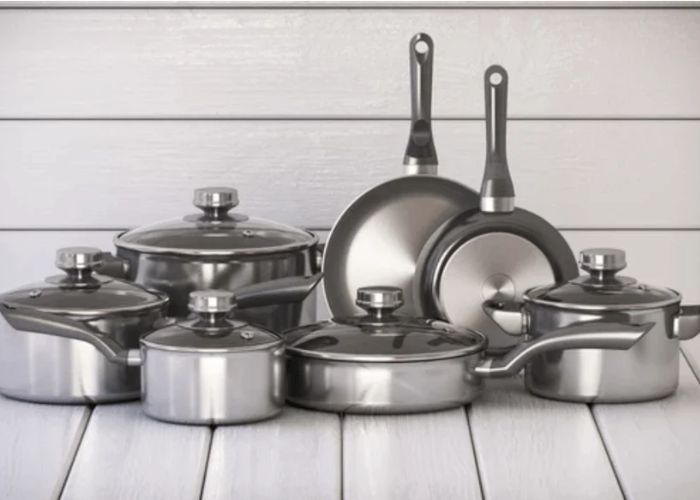When it comes to essentials for the kitchen, stainless steel utensils stand out as options that are adaptable, long-lasting, and pleasing to the eye. The right arrangement of hardened steel utensils can upgrade your cooking experience and raise the general usefulness of your kitchen. However, choosing the best stainless steel utensils can be difficult due to the abundance of options on the market.
By providing you with essential information on the characteristics, types, and factors to consider when selecting stainless steel kitchen utensils, this comprehensive guide aims to simplify the decision-making process. Let’s read below “How can I choose the best stainless steel utensils for my kitchen?”
Understanding Stainless Steel
Before diving into the specifics of selecting the best stainless steel utensils, it is essential to comprehend the material. An alloy of iron, chromium, nickel, and other elements is stainless steel. The presence of chromium adds to tempered steel’s consumption obstruction, pursuing it an optimal decision for cooking wares. The ratio of these elements determines the grade of stainless steel, with 304 and 316 being the most common grades.
Grade Matters:
The quality, durability, and resistance to corrosion of stainless steel are all heavily influenced by its grade. While picking utensils, decide on those produced using 304 or 316 treated steel. Grade 304 is suitable for the majority of kitchen applications, whereas grade 316 is more resistant to corrosion and suitable for salinity-rich environments like coastal areas.
Consider the Composition:
Utensils made of stainless steel can have a one-ply or multi-ply construction. Multi-ply utensils have multiple layers, often with an aluminum or copper core, whereas single-ply utensils only have one layer of stainless steel. Multi-utilize development improves heat appropriation and gives better cooking execution.
Types of Stainless Steel Utensils
Since we have a fundamental comprehension of tempered steel, we should investigate the different kinds of utensils accessible and contemplations for each:
Cookware:
Due to its durability and adaptability, stainless steel cookware is a popular choice. While choosing treated steel pots and skillet, think about the thickness of the material. Thicker cookware will in general appropriate intensity all the more equally and is less inclined to distorting. Pots and pans with lids that fit snugly to preserve flavors and nutrients should have ergonomic handles for a comfortable grip.
Cutlery:
Hardened steel cutlery is a staple in each kitchen. Consider the knife’s overall weight and blade thickness when selecting a knife. The safe and effective preparation of food is ensured by a knife that is balanced and has a sharp edge. Also, think about how the handle looks and how comfortable it is to use for a long time.
Flatware:
There are a variety of designs and finishes available for stainless steel dining flatware, such as forks, spoons, and knives. Consider the style that supplements your silverware and the heaviness of the tableware for an open-to-eating experience. Top-notch tempered steel silverware is impervious to erosion and can endure regular use and washing.
Bakeware:
Bakeware made of stainless steel, such as cake pans and baking sheets, is renowned for its durability and uniform heat distribution. Search for bakeware with a clean surface for simple food delivery and cleaning. Bakeware made of non-reactive stainless steel will not impart any undesirable flavors to baked goods.
How can I choose the best stainless steel utensils for my kitchen?
Budget:
Set a financial plan before looking for hardened steel utensils. While top notch hardened steel utensils might accompany a more exorbitant cost tag, they frequently offer better strength and execution over the long haul. It’s like making a kitchen investment.
Brand Reputation:
Choose reputable brands that have a track record of producing stainless steel products of superior quality. Find testimonials and reviews from previous customers to evaluate a brand’s dependability and performance.
Maintenance:
Utensils made of stainless steel are usually easy to clean, but some may need special attention. Verify whether the tools can be washed in the dishwasher or by hand. Moreover, consider the simplicity of cleaning and whether the utensils are impervious to stains and staining.
Cooking Style:
Your preferences and cooking style should guide your selection of stainless steel utensils. On the off chance that you appreciate singing and searing, pick treated steel cookware with a thick base for even intensity dispersion. Knives with a comfortable grip and a sharp edge are best for precise cutting.
Appearance:
While style may not be the first concern, the presence of your treated steel utensils can upgrade the general look of your kitchen. Whether you want a matte, brushed, or polished finish, choose one that goes well with the decor in your kitchen.
Warranty:
Check the guarantee presented by the producer. The manufacturer’s confidence in the quality and durability of their stainless steel utensils is demonstrated by a dependable warranty.
Conclusion
Choosing the best-treated steel utensils for your kitchen includes thinking about different variables, including level, development, sorts of utensils, spending plan, brand notoriety, support, cooking style, appearance, and guarantee. By understanding these components, you can settle on informed choices that line up with your cooking needs and inclinations.
Putting resources into excellent tempered steel utensils improves your culinary experience as well as adds to the proficiency and feel of your kitchen. With the right arrangement of utensils, you can set out on a culinary excursion where sturdiness, usefulness, and style consistently meet in the core of your home. I hope you like reading “How can I choose the best stainless steel utensils for my kitchen?”

